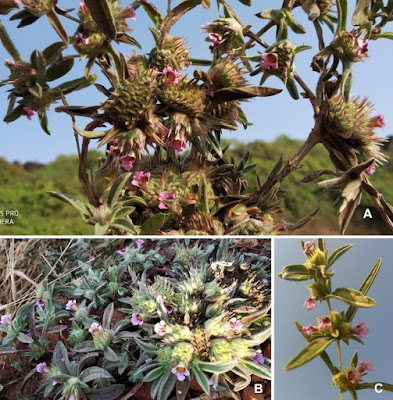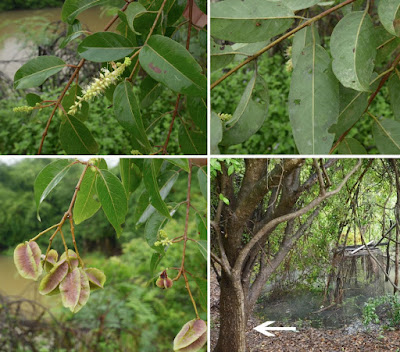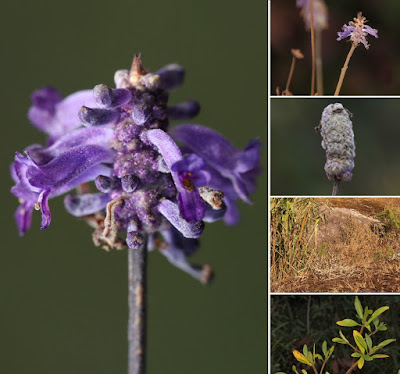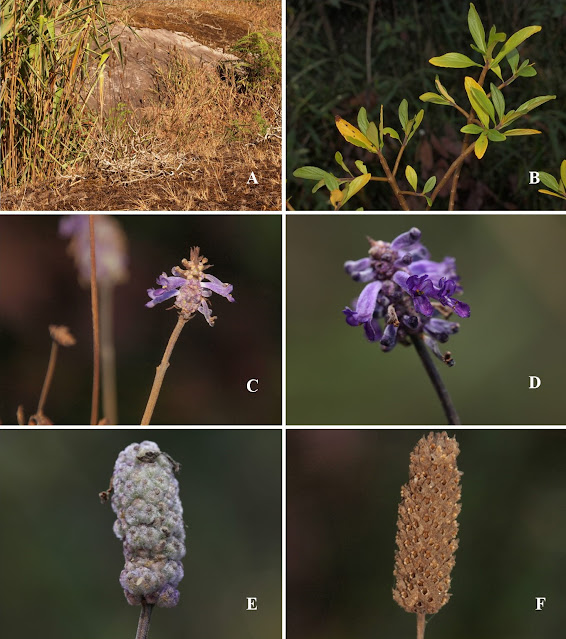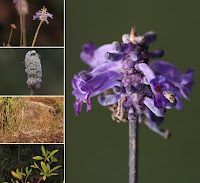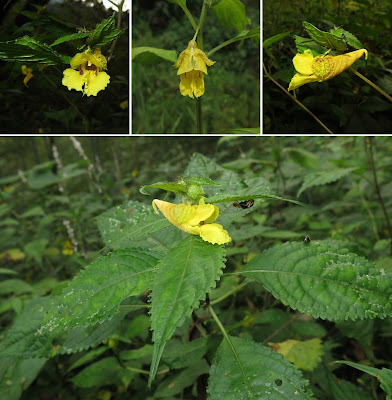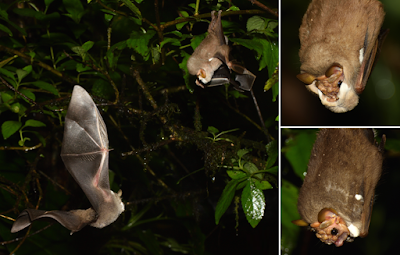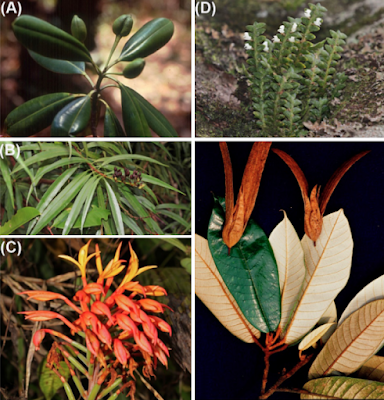[Most Recent Entries] [Calendar View]
Monday, November 16th, 2020
| Time | Event | ||||
| 12:00a | [Botany • 2019] Lepidagathis shrirangii (Acanthaceae) • A New Species from Konkan Region of Maharashtra, India Abstract Lepidagathis shrirangii, a new species of Lepidagathis is described and illustrated from Ratnagiri district of Maharashtra, India. The new species is closely allied with L. lutea, which was also described from Konkan region of Maharashtra. Coloured photographs, notes on the relationship and the key to the species with two seeds and five sepals is provided to facilitate the identification. Keywords: Lepidagathis, coastal region, lateritic plateaus, taxonomy, endemism, Eudicots
Lepidagathis shrirangii Natekar, Kambale & Chandore, sp. nov. Lepidagathis shrirangii is similar to L. lutea Dalzell (1850: 139), but differs in its cylindrical, terete stem (not quadrangular), ensiform leaf (not linear), ciliate margin (not entire), acuminate (not acute) leaves at apex, pink flowers (not yellow), 15–17 (not 8–10) spikes in erect branch, slightly cuspidate bracts (not caudate) at apex, cuspidate sepals (not acuminate) at apex. Pratik Dilip Natekar, Devidas Bhausaheb Borude, Sharad Suresh Kambale and Arun Nivrutti Chandore. 2020. Lepidagathis shrirangii (Acanthaceae) A New Species from Konkan region of Maharashtra, India. Phytotaxa. 405(4); 215–220. DOI: 10.11646/phytotaxa.405.4.6 | ||||
| 12:20a | [Botany • 2020] Terminalia santisukiana (Combretaceae) • A New Species from North-Eastern Thailand
ABSTRACT A new species of Terminalia, Terminalia santisukiana (Combretaceae) from fresh water swamp forest in North-Eastern Thailand is described and illustrated. The new species is similar to Terminalia nigrovenulosa, having similar leaves with glands on the leaf margin near the base and paniculate inflorescences, but it is mainly distinguished by the loose panicles with dense indumentum on the flowers and the 4–5-winged fruits. It is also similar to Terminalia polyantha, having 4–5-winged fruits, but differs by the dense indumentum on the flowers and asymmetrical fruits. Keywords: Fresh water swamp forest, Sakon Nakhon, Terminalia nigrovenulosa, Terminalia polyantha Terminalia santisukiana Patthar. & Poopath, sp. nov. Similar to Terminalia nigrovenulosa Pierre by similar leaves with glands on their margin near the base and paniculate inflorescences, but differing in its outer bark being smooth or scaly outside, inner bark yellowish brown, loose panicles with a dense indumentum, whitish flowers that are densely pubescent on the outside at the base of the receptacle (lower receptacle) and pubescent inside towards the apex of the receptacle (upper receptacle), and ovoid to broadly ellipsoid (4–)5-winged fruits (versus smooth outer bark with shallow longitudinal streaks, bright orange-red inner bark, compact panicles, pale yellow flowers that are glabrous outside at the base of the receptacle, and oblong, (2–)3-winged fruits in T. nigrovenulosa). It is also similar to Terminalia polyantha C.Presl, from the Philippines, in having 4–5-winged fruits, but it differs in flowers with a dense indumentum on the apex of the receptacle, asymmetrical fruits, and growing in fresh water swamp forest (versus flowers glabrous at the apex of the receptacle, symmetrical fruits, and growing in dry thickets and secondary forests). Ecology.— Fresh water swamp forest, along the Nam Un River, branch of the Songkhram River, a tributary of the Mekong River; ca 150 m alt. Vernacular.— Khi ai nam (ขี้อ้ายน้ำ), saeng kham tham (แสงคําทาม), saen kham tham (แสoคําทาม) (General). Etymology.— The species is named in honour ofthe late Prof. Dr Thawatchai Santisuk (1944–2020),who was an editor of the Thai Forest Bulletin (Botany)(1991–2013) and Editor-in-Chief of the Flora of Thailand (1997–2013). Nannapat Pattharahirantricin and Manop Poopath. 2020. Terminalia santisukiana (Combretaceae), A New Species from North-Eastern Thailand. Thai Forest Bulletin (Botany). 48(2); 199-203. DOI: 10.20531/tfb.2020.48.2.12 | ||||
| 2:00a | [Botany • 2020] Coleus bolavenensis (Lamiaceae) • A New Species from Bolaven Plateau, southern Laos
ABSTRACT Coleus bolavenensis, a new species from Bolaven Plateau, southern Laos is described and illustrated. A preliminary conservation status is provided. Keywords: Anisochilus, Bolaven Plateau, Champasak Province, Dong Hua Sao NPA
Coleus bolavenensis Suddee, Tagane & Rueangr., sp. nov. Similar in morphology to Coleus harmandii (Doan ex Suddee & A.J.Paton) A.J.Paton but differs in having inflorescences simple (vs much branched in C. harmandii), leaves almost glabrous, with short hairs on mid-vein and secondary veins beneath (vs tomentose beneath in C. harmandii), and corolla bluish-purple (vs white or whitish-purple in C. harmandii). Etymology.— The epithet refers to the type locality.    Somran Suddee, Shuichiro Tagane, Phetlasy Souladeth, Deuantar Kongxaisavath, Sukid Rueangruea, Yoshihisa Suyama and Eizi Suzuki. 2020. Coleus bolavenensis (Lamiaceae), A New Species from Laos. Thai Forest Bulletin (Botany). 48(1), 82-85. DOI: 10.20531/tfb.2020.48.1.14 | ||||
| 2:01a | [Botany • 2020] Impatiens plicatisepala (Balsaminaceae) • A New Species from Guangxi, China
Abstract Impatiens plicatisepala C. Y. Zou, Yan Liu & S. X. Yu (Balsaminaceae), a new species from Ziyuan County Guangxi, China, is described and illustrated. It is closely related to Impatiens davidii Franchet and Impatiens dicentra Franchet ex J. D. Hooker, all of them having 1-flowered inflorescence and basal lobe of lateral united petals with a filamentous hair. This new species has unique characters and differs from its relatives by plicated sepals, rugose seeds and two bracts in different shapes. Keyword: Balsaminaceae, China, Impatiens, Impatiens davidii, Impatiens dicentra, morphology, new species, taxonomy Impatiens plicatisepala C. Y. Zou, Yan Liu & S. X. Yu,sp. nov. 褶萼鳳仙花 Diagnosis: Impatiens plicatisepala differs from I. davidii and I. dicentra in the stipitate glands at leaf base, the dimorphic bracts (one linear, the other broadly ovate), the broadly ovate and abaxially plicate lateral sepals, and the ellipsoid and rugose seeds. .... Distribution and habitat: At present Impatiens plicatisepala is only discovered in Ziyuan County in northern Guangxi, China. It grows directly in open or partly shaded moist places, along streams and muddy places, between 1000–1500 m. Etymology: The specific epithet ‘plicatisepala’ is named according to the characteristic of plicated lateral sepals Chun-Yu Zou, Yan Liu, Jin Li and Sheng-Xiang Yu. 2020. Impatiens plicatisepala (Balsaminaceae), A New Species from Guangxi, China. Taiwania. 65(4); 544‒547. DOI: 10.6165/tai.2020.65.544 | ||||
| 2:02a | [Mammalogy • 2020] The Masked Seducers: Lek Courtship Behavior in the Wrinkle-faced Bat Centurio senex (Phyllostomidae)
Abstract Centurio senex is an iconic bat characterized by a facial morphology deviating far from all other New World Leaf Nosed Bats (Phyllostomidae). The species has a bizarrely wrinkled face and lacks the characteristic nose leaf. Throughout its distribution from Mexico to Northern South America the species is most of the time rarely captured and only scarce information on its behavior and natural history is available. Centurio senex is frugivorous and one of the few bats documented to consume also hard seeds. Interestingly, the species shows a distinct sexual dimorphism: Adult males have more pronounced facial wrinkles than females and a fold of skin under the chin that can be raised in style of a face mask. We report the first observations on echolocation and mating behavior of Centurio senex, including synchronized audio and video recordings from an aggregation of males in Costa Rica. Over a period of 6 weeks we located a total of 53 perches, where during the first half of the night males were hanging with raised facial masks at a mean height of 2.35 m. Most of the time, the males moved just their wing tips, and spontaneously vocalized in the ultrasound range. Approaches of other individuals resulted in the perching male beating its wings and emitting a very loud, low frequency whistling call. Following such an encounter we recorded a copulation event. The observed aggregation of adult C. senex males is consistent with lek courtship, a behavior described from only few other bat species. Conclusion: Our study summarizes the first behavioral data from a lek of Centurio senex males, observed over a period of almost 6 weeks at a Costa Rican highland forest site. The exclusively male bats used stable perches and showed distinct behavioral patterns including an acoustic signaling with stereotypical elements that might serve to attract females and perhaps also to signal male quality. Perching animals were regularly approached by other individuals and in one case such an encounter was followed by a copulation. Males often spent several hours on the perch without leaving and abandoned it only after midnight. This endurance left males with only half of the night time for foraging, so the time spent on the perch is a significant energetic investment and could be a honest signal for male quality. Our study has some obvious shortcomings. While we were extremely lucky to obtain the first observations on the behavior of this interesting species we deliberately refrained from mist-netting bats in order not to scare the animals away from our study site. The downside of this cautious approach is, however, that we still lack essential data, such as the sex ratio at the site, the body condition of individual males or the identity of all visitors. In this context, it would also be highly interesting to assess potential olfactory signals of the perching males, perhaps in the facial region. Hopefully, the encounter of a future lek of Centurio senex will allow us to close some of the current gaps in the knowledge on the behavior of one of the most iconic bats of the Neotropics. Bernal Rodríguez-Herrera, Ricardo Sánchez-Calderón, Victor Madrigal-Elizondo, Paulina Rodríguez, Jairo Villalobos, Esteban Hernández, Daniel Zamora-Mejías, Gloria Gessinger and Marco Tschapka. 2020. The Masked Seducers: Lek Courtship Behavior in the Wrinkle-faced Bat Centurio senex (Phyllostomidae). PLoS ONE. 15(11): e0241063. DOI: 10.1371/journal.pone.0241063 Wrinkle-faced male bats lower face masks to copulate The first behavioral observations of wrinkle-faced bats in their natural habitat reveal that this elusive species uses the rarest form of bat courtship behavior, according to a new study. | ||||
| 2:22a | [Botany • 2020] A Synopsis of the Endemic Plant genera of Borneo Abstract The large, tropical island of Borneo has some of the world's richest habitats for plant life, but faces increasing pressures from anthropogenic activities that threaten its biodiversity. With a good portion of the Bornean flora not critically studied, a comprehensive documentation of the numerous endemic taxa expected for the island is not yet complete. It is not known what the relative significance of endemic genera is compared to Bornean centres of endemism documented or predicted through modelling, and if they can inform current conservation plans. As a first step, we here present a synopsis of the endemic genera of Borneo, based on a comprehensive study of literature, herbarium specimens and distributional data, and an investigation of whether the genera have been included in molecular phylogenetic studies that confirm their monophyly. Such a review is timely since many generic delimitations have been shaped by molecular evidence used to test morphology‐based taxonomy, while botanical collection and revisionary efforts continue. Our findings suggest that 65 vascular plant genera from 25 families may be considered endemic to Borneo. More than two‐thirds (48) of these genera have had at least one species included in molecular phylogenetic studies, but of these, only 39 have been sufficiently sampled to be considered monophyletic with high confidence, or they are monotypic. Slightly over half (38) of the endemic genera are herbaceous. A majority of the genera have fruits or seeds specialised for dispersal by abiotic vectors, or unspecialised seeds. Almost two‐thirds (42) of the endemic genera are monotypic, and some of these could represent relict lineages. We expect the current list of endemic genera to be relatively stable and aligned with recent taxonomic concepts, and that it serves to illuminate an interesting aspect of Borneo's unique assemblage of endemic species. Keywords: biogeography, conservation, endemism, Malesia, Sundaland, taxonomy Louise Neo, K. M. Wong and Hugh T. W. Tan. 2020. A Synopsis of the Endemic Plant genera of Borneo. Nordic Journal of Botany. DOI: 10.1111/njb.02871 |
| << Previous Day |
2020/11/16 [Calendar] |
Next Day >> |
